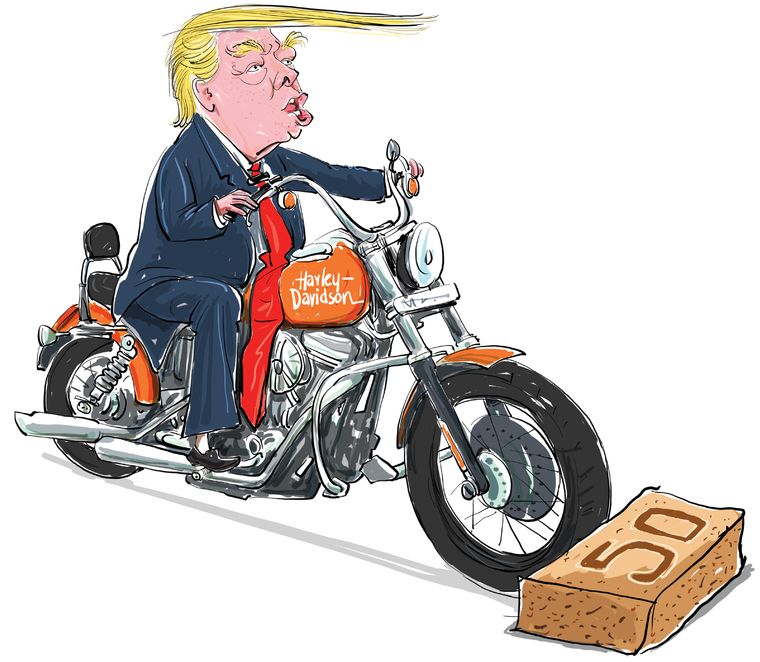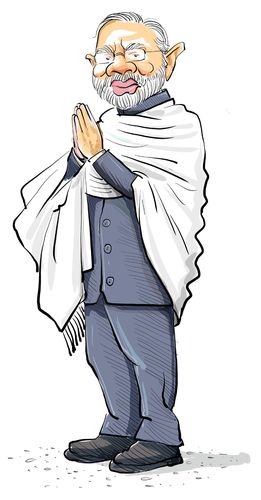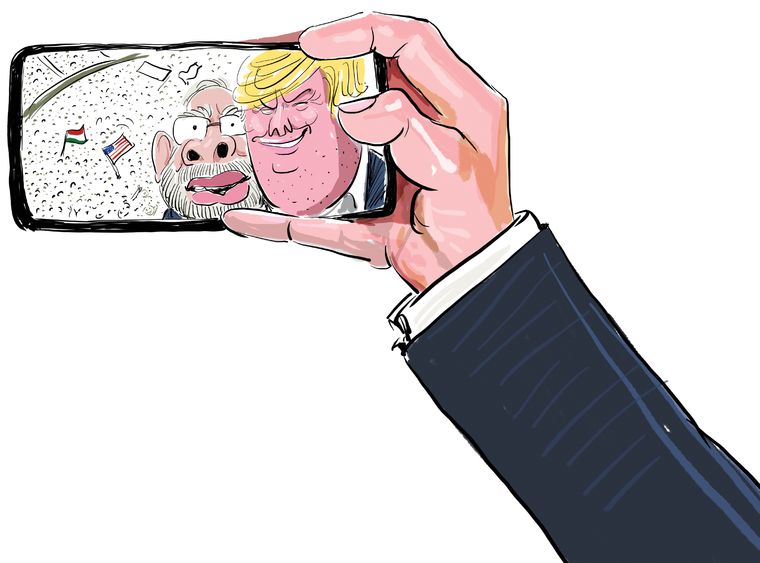Size does matter for US President Donald Trump. On February 24, Ahmedabad will outdo Houston when the biggest stadium in the world hosts the most powerful man in the world in what is touted as the greatest show on earth.
The cost of the show in Ahmedabad is said to be over Rs80 crore. Paan shops are being sealed, palms are being hurriedly planted and walls are coming up as part of the city’s beautification. Numbers, too, matter, for Trump. He says he is expecting up to seven million people to welcome him. His facts may not be accurate, but the Trump visit at the moment is all about optics.
Blame Texas. Everything is big in Texas. The ‘Howdy, Modi!’ event added a different dimension even to the large Texan scale. Trump was finally trumped on his home ground. And now, Modi is going to do it again, this time in front of millions, hoping to turn the show into a diplomatic power move. India is rolling out the red carpet and Trump, a reluctant traveller, is ready for the ride.
This is not the first time that Modi has invited Trump to India. An invitation was sent out for last year’s Republic Day function; but the Americans were a little squeamish about endorsing a candidate in an election year. Modi, however, has no such qualms. He is hosting Trump at a time when the US president is launching his reelection campaign knowing fully well that the visit will boost his image back home.
“I view it through the prism of politics,’’ said Harsh Pant, who heads the strategic studies programme at Delhi-based think tank Observer Research Foundation. “Trump is coming to India because at Houston Modi sold him this idea that he has hold over the Indian diaspora. Indian Americans are traditionally Democratic voters and Trump thinks that he has nothing to lose if a few of them come to him.”
According to a survey by the Asian American Legal Defense and Education Fund, 80 per cent of Indian Americans voted for Hillary Clinton in 2016. This year, there will be 1.4 million Indian American voters. “When Modi held Trump’s hand and led him around the stage in Houston, saying ‘meet my family’, Trump was impressed,’’ said Adrian Mutton, a British businessman who was sitting in the front row. Trump, who has been facing a barrage of criticism in his own country, felt love at the event. He will want to build on it. And, to underscore the importance of the relationship, Trump is bringing his team of Indian Americans—at the last count, there will be 22 members.
The domestic compulsions of the trip apart, it is also about business. Presidential visits clearly articulate foreign policy priorities. So Trump’s visit will help affirm India’s importance. “I am getting a little worried about too much focus on the stadium event. I hope that there will be some strong policy developments as well,” said Alyssa Ayres, senior fellow at the Council on Foreign Relations, a leading American think tank.
Unlike earlier presidential visits, which were planned well in advance, the Trump visit—even though the dates have been floating around for a while—looks increasingly unusual, with the agenda not completely mapped out. Trade is a major sticking point. According to the latest reports, US Trade Representative Robert Lighthizer is not part of the presidential delegation. Trump himself ruled out the possibility of a trade deal on February 19. But many observers believe that despite all the posturing and brinksmanship, a deal is still possible.
“President Trump’s visit is different from president Clinton’s visit, which was carefully prepared,’’ said former ambassador to India Richard Celeste. “The Clinton visit, which lasted five days, set a standard for expectations for presidents to take the time to travel half way across the world to India. In that respect, the Trump visit is consistent with the previous practice. The shape of the visit is a different matter. The visit is an expression of how Trump personalises foreign policy. So, how do you explain the timing or the substance? You cannot evaluate that in a traditional way.’’
It is no secret that trade negotiations between India and the US have floundered for years. Things took a change for the worse with Trump. For the first time, foreign policy is being viewed through the prism of economics. Trump is unhappy about trade deficits and in 2019, the US ran a deficit of $23.3 billion vis-a-vis India. Trump has used the word “unacceptable” a lot to describe the high deficit and the hefty tariffs imposed by India on products such as Harley-Davidson motorcycles.
“Lighthizer’s absence signals that there may not be a formal trade deal. But despite the brinksmanship displayed by both sides, at least side deals are still possible,” said Rajat Kathuria, director and chief executive of the Indian Council for Research on International Economic Relations. With India deciding to stay out of the Regional Comprehensive Economic Partnership, a free trade regime in the Asia-Pacific, a trade agreement with the US or the European Union is even more crucial, according to Kathuria.
Last year, the Trump administration eliminated preferential tariffs to Indian exports under the Generalised System of Preferences (GSP), a move which cost India $6.3 billion. India responded by levying duty on 28 American goods worth $1.4 billion, covering stuff like almonds, cashews, apples, chickpeas and wheat. This is bound to be a sticking point in trade negotiations.
Apart from trade issues, India also needs to take up with the US the decision to cap H-1B visas for Indians at 15 per cent. The US, meanwhile, is unhappy about India’s insistence on data localisation for payment providers like credit card companies, which are mostly American. Lighthizer’s deputy Jeffrey Gerrish had warned that India’s data localisation policies could be a deal-breaker across the board. Taxation of internet giants, which India is likely to propose soon, will be another major point of contention. Trump is likely to fight tooth and nail to protect his country’s massive advantage in the emerging digital economy space.
“The visit will work out well even if the agreement to reduce some trade friction is not finalised,’’ said Richard M. Rossow of the Centre for Strategic and International Studies, Washington, DC. “The US hopes to win new export agreements, and the visit—and agreement negotiations—have reduced tensions overall. This is important as India continues to place new trade barriers, notably through the tariff hikes included in the Union budget.’’
India will be hoping that the Trump visit goes beyond just the hype, trade and numbers, and cements bilateral relations further. “I think the challenge has really been to channel the energies and the positive sentiments,’’ said Minister of External Affairs S. Jaishankar in the Raisina Dialogue held in January. “And, if you look, today there is virtually no area of activity where India and the United States do not work with each other and deal with each other.’’
More importantly, Trump’s visit brings the possibility of closer cooperation in strategic affairs. Trump has done what no American president has ever done—he has made the dragon crouch, not only with the trade war, but also with the backing he has given India in multilateral institutions. “The only thing that matters to us is China,’’ said Rajesh Rajagopalan, who teaches international relations at Jawaharlal Nehru University. “We can handle Pakistan, but without the US, we cannot balance China.”
Namaste Trump.
The Prime Minister (Modi), who I think is a fantastic man, called me the other day. He said, ‘We are lowering it (import duty on Harley-Davidson motorcycles) to 50 per cent.’ I said, ‘Okay, but so far we’re getting nothing.’ So we get nothing, he gets 50 [per cent], and they think... like they’re doing us a favour. That’s not a favour.
FEBRUARY 26, 2018
TRUMP AT THE WHITE HOUSE BUSINESS SESSION WITH GOVERNORS
I remember India before... and it was very torn. There was a lot of dissension, a lot of fighting. And he (Modi) brought it all together, like a father would bring it together. Maybe he’s the father of India. We’ll call him ‘the father of India’. I think that’s not so bad.
SEPTEMBER 24, 2019
TRUMP AT THE UN HEADQUARTERS, NEW YORK, AHEAD OF A MEETING WITH MODI
We’re not treated very well by India, but I happen to like Prime Minister Modi a lot. And he told me we’ll have 7 million people between the airport and the event [in Ahmedabad].... So it’s going to be very exciting.
FEBRUARY 18, 2020
TRUMP SPEAKING TO THE MEDIA AT THE JOINT BASE ANDREWS, MARYLAND





